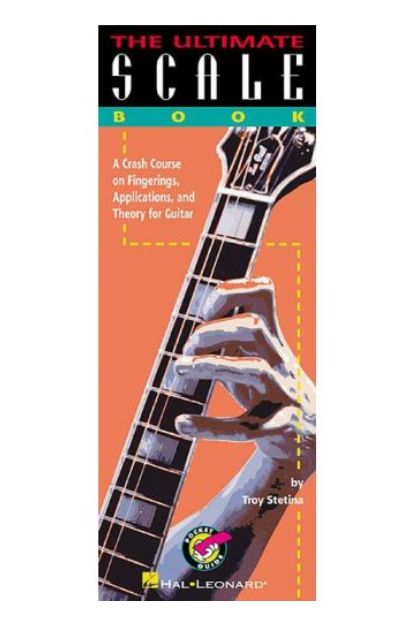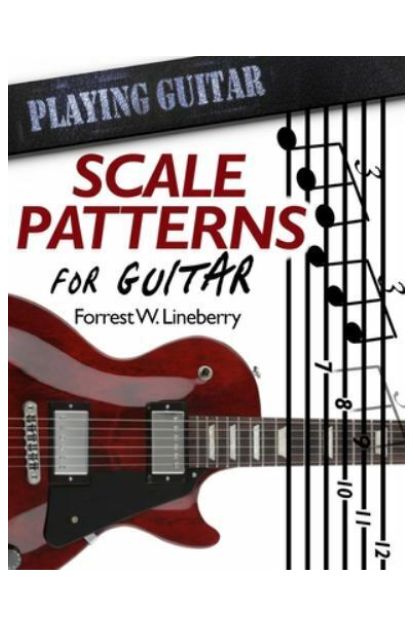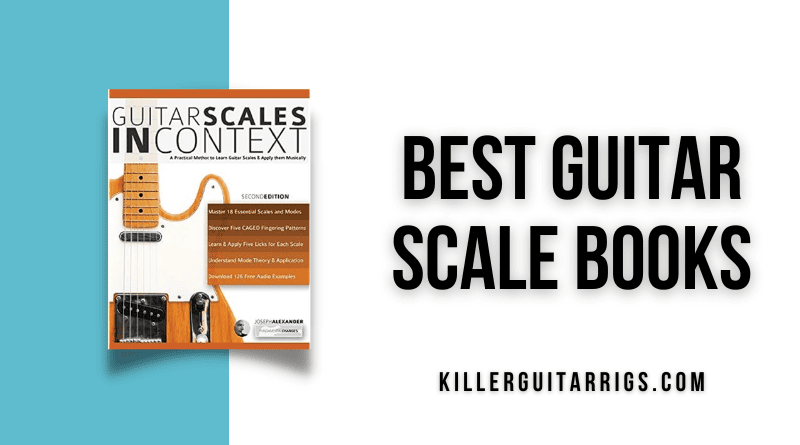Having on-demand access to YouTube and other online resources really has made learning guitar so much easier than it was even 20 years ago. The real problem is, what happens when you don’t have access to your phone or tablet? Call us old-fashioned, but at KGR, we still find a lot of value in having an extensive library of real guitar books. Particularly guitar scale books.
A decent scale book will help you understand and apply the cornerstone of musical expression. Scales are heavily present in nearly every musical facet, from melodies and improvisations all the way to compositions and other concepts.
As guitarists, learning scales will also be of great help to learn the fretboard and find your way around the instrument. A good guitar scale book will help you internalize scale shapes and positions. In return, this will improve your understanding of chords, melodies, and solos.
As you may imagine, there are countless guitar scale books on the market. In this KillerGuitarRigs Review, we’ll show you our picks out of the wealth of scale books available today. During the review, we focused on practicality, how well the concepts were explained, audio resources, and clear notation (both standard staff notation and tabs). Keep reading to learn more!
Read more about our review process.
Individual Reviews

Guitar Scales in Context
An easy to apply compendium of scales.
This guitar scale book is a comprehensive resource that will serve you for years to come. It covers everything from basic scales, all the way to the modes and beyond. Mastering the scales covered in this book will be an important step toward becoming a great guitarist.
From the biggest name in guitar books on Amazon, Fundamental Changes, comes Guitar Scales in Context. As with so many of their books, this provides a step-by-step process for learning the most essential 18 guitar scales and modes. This book not only teaches these scales but also provides backing tracks and licks for each one, so we were able to put them to use immediately.
One of our favorite things about this book was that each chapter is dedicated to a separate scale. We started with Chapter I, which featured the major scale, explained in great detail but in a simple and easy-to-understand language. This laid the foundation for all the scales that followed. We found that once you understand how to internalize the major scales, the learning process unlocked itself with this book.
We loved the fact that Guitar Scales in Context went well beyond the modes of the major scale. In this book, we found more advanced scales like the Mixolydian Bebop Scale, which is great for anybody interested in understanding a little bit more about jazz.
Other scales, like the Harmonic Minor Scale, were also explained in detail. This particular scale is not only good for providing guitarists with a comprehensive understanding of one of the three main types of minor scales but also a great resource for metal guitarists to have under their fingers.
While going through this book and playing each exercise, we loved how well-organized it was. Each chapter increased the level of complexity and difficulty progressively and in a logical way. Guitar Scales in Context gave us clear diagrams, standard notation, and tabs, as well as sound advice to take one scale at a time, with practical tips on how to approach each chapter.
Each chapter came with several diagrams that explained where each of the respective scales needed to be played. For instance, the chapter on whole scales and diminished scales came with five diagrams. These did a good job of illustrating where this scale could be played, from the first fret all the way to the seventeenth fret. In other words, we got an explanation for where to play each scale across the entire fretboard.
Verdict: Guitar Scales in Context offers you a complete explanation of the main 18 types of scales for guitarists. This book will likely last you a long while as it goes from basic scales to very advanced ones. Besides clear diagrams, notation, and tabs, you also get backing tracks and licks for each scale explained, which is a fantastic feature that allows the user to get immediate context on the scale being learned.

The Ultimate Scale Book
A convenient pocketbook for students.
If you are looking for convenience at a bargain price, this scale pocketbook is a fantastic choice. It features everything you need to know about scales in order to get started and advance significantly in your journey as a guitarist. Although it is inexpensive and relatively small, this book will be of great use to beginners and mid-level players.
Troy Stetina’s Ultimate Scale Book is a perfect blend of practicality and useful information. Although much smaller than a regular book (it fits in your back pocket), it includes detailed information for both the beginner and the student who has some experience but wants to go a bit deeper.
This scale book started out by giving us in-depth information on what a scale is and how it is formed. This is essential information that will be of great help for anybody to understand how scales work and how to make sense of them while applying them in a musical context.
Besides going into simple, easy-to-understand details on a scale, the Ultimate Scale Book also offered insight into how to learn and practice scales. We felt that this book goes a step beyond what many other books offer by laying out in clear and straightforward terms how the process of internalizing scales works. This is a crucial aspect for anybody who wants to integrate scales into their playing, composing, arranging, etc.
We also loved the fact that this book gave us the choice to either read the musical notation, read the tab, or rely on the diagrams to learn the scale. Naturally, the optimum way was to combine at least two of these methods.
In our case, we got the most out of this book by reading the musical notation and reinforcing it with the diagrams. This process allowed us not only to get a clear understanding of the intervals that make up each scale but also to have a visual map of scales on the fretboard, thanks to the detailed diagrams.
The scales covered in the Ultimate Scale Book were varied and went from basic to advanced. Everything from easier scales like the minor pentatonic and blues scales to more advanced ones like the whole tone and diminished scales is there.
Additionally, this pocketbook goes beyond just the major modes and even delves into the modes of the melodic minor scale. And because it is smaller and thinner, you can keep the Ultimate Scale Book near to use it as a reference, as well as make it your go-to book for learning and working on scales.
Verdict: The Ultimate Scale Book is a great choice for students and mid-level players who want a reliable, inexpensive, and convenient reference book for working on scales. It covers everything from basic scales used on primitive blues all the way to more advanced scales used for jazz and bebop improvisation. In short, this book will likely last you a long time as there is enough material there for years worth of work.

Scale Patterns for Guitar
An approach based on melodic sequences for applying scales.
This book relies on melodic passages or sequences in order to help the reader better internalize scales. This is based on the principle that when improvising, composing, or playing music in general, one does not just run up and down the scale. In essence, this book does a good job of providing context and real-life examples of how scales may present themselves and be used in music.
Scale Patterns for Guitar by Forrest W. Lineberry is a fantastic book for guitarists who want a more musical approach to learning scales. The entire premise of this comprehensive book is to make the guitarist avoid sounding like they’re just playing up and down the scale – ideal if you’re trying to become a better improviser.
We really appreciated how the author explained what a scale is in musical terms and through examples. This was of great help for further understanding the infinite patterns that a scale can provide.
Scale Patterns for Guitar is especially good for beginners, as it exemplifies exactly what the pattern sounds like via the included audio bites. The patterns in this book were presented not only with standard notation but also via tab.
We also loved how this book went the extra mile by using Beethoven’s 5th Symphony as an example and broke down the beginning into patterns that naturally belong to a scale. It broke down some of the musical phrases at the start of this piece and wrote them out for the guitarist to read. The author then analyzed these phrases in a simple and easy-to-understand way and linked them to patterns that we could use on the guitar for improvisation and composition. This was easily one of our favorite approaches we’ve seen in a book like this.
Additionally, Scale Patterns for Guitar came with fingerings all laid out clearly. This is a fantastic feature, as it gave us no doubt on how to finger the proposed patterns. As a result, we were able to focus exclusively on the pattern and how it related to the parent scale.
We also loved how this book helped us with our dexterity. Some of the patterns presented were also great as finger coordination exercises. With the use of a metronome, we were able to get a great finger workout from this book, especially by focusing on some of the more complex patterns. Furthermore, these were patterns that we could include in each of our own bags of tricks for improvising in nearly any genre, as well as for songwriting.
Verdict: Scale Patterns for Guitar is a great resource for dealing with the common issue of just playing scales up and down in a sequential and linear fashion. It does this by presenting patterns that use the scale in question. The user is presented with the basic form of the scale and then patterns that use said scale in a more musical way. In short, it is a great book that allows beginners and even mid-level guitarists to approach scales in a more natural and organic way.
How To Pick the Right Book For You
Learning scales is a vital aspect of grasping the guitar. No matter if you’re a beginner eager to get started with scales or a mid-level player aiming to get serious, a good guitar scale book can be an invaluable resource. Below, we share a few of the most important factors to consider when selecting a guitar scale book.
Assessing your level
The first consideration when choosing a guitar scale book is your level of expertise. Many books are specifically designed for a particular skill level, do determine if you’re at beginner, intermediate or advanced level and then ensure that the content matches your abilities. Beginners should seek books that provide clear explanations, basic fingerings, and fundamental music theory, while more advanced players may require more complex scales and advanced techniques.
Types of scales
A good guitar scale book should cover a wide range of scales and modes. Look for a book with commonly used scales like major, minor, pentatonic, blues and modes such as Dorian, Phrygian, and Lydian. Additionally, consider if the book scales even more like diminished, whole tone, etc.
Other aspects, such as arpeggios or a bit of harmony, may also come in handy. A diverse collection of scales will expand your musical vocabulary and allow you to play in various genres and styles. Below, we give you a list of the common scales for a guitar scale book, going from the most simple to the most complex ones.
Major Scale
The major scale is the fundamental building block of Western music. This scale is made of seven notes and an octave and follows a specific pattern of whole and half steps. Learning the major scale well is a powerful first step to unlocking modes, as well as understanding how the entire process of learning a scale works.
Minor Scale
The minor scale possesses a distinct character that evokes melancholy and contemplation. It is widely used in various genres, including rock, blues, and jazz. The most common type of minor scale is the natural minor scale, which is obtained from the major scale by lowering the third, sixth, and seventh scale degrees. In other words, you can get to the minor scale by altering three notes on the major scale. The minor scale provides a rich palette for expressing emotion and creating haunting melodies.
Pentatonic Scale
This is typically where you’d start as a guitarist. However, we did not put it first on this list because this scale derives from the major (or minor) scale. The pentatonic scale is a five-note scale widely used in blues, rock, and country music. Its simplicity and versatility make it a favorite among guitarists, and because it is easier than the major and minor scales, it is typically a starting point for learning scales.
The major pentatonic scale is obtained from the major scale by removing the fourth and seventh scale degrees, while the minor pentatonic scale comes from the natural minor scale by removing the second and sixth degrees. The pentatonic scale’s characteristic sound allows for expressive soloing and provides ample room for improvisation.
Blues Scale
Think of the blues scale as a close sibling to the pentatonic scale. The blues scale adds a “blue note” (a flattened fifth) to create a distinctly bluesy sound. It is an essential scale for guitarists delving into blues, jazz, and rock genres. Sometimes, the blues scale is taught before the pentatonic scale. However, a more logical progression would be to learn the minor pentatonic scale and then the blues scale.
In any case, the blues scale is often used alongside the pentatonic scale and allows players to inject soulful bends, slides, and expressive phrasing into their solos.
Modes
Modes get a bad rep among some guitarists but are an important part of playing guitar. Modes are basically variations of the major scale and offer different tonal flavors. Guitarists can explore various modes, such as Dorian, Mixolydian, Phrygian, and Lydian, among others. Each mode has its own unique set of intervals and distinctive flavors.
Understanding and applying modes can greatly expand a guitarist’s harmonic and melodic possibilities, enabling them to create diverse musical textures and explore complex chord progressions.
Harmonic and Melodic Minor Scales
The harmonic minor scale introduces a raised seventh degree compared to the natural minor scale, providing a hint of tension and intensity. It is commonly used in classical, flamenco, and metal music.
The melodic minor scale, on the other hand, raises the sixth and seventh degrees of the natural minor scale while ascending but reverts to the natural minor scale when descending. This scale adds a touch of sophistication to improvisations and lends itself well to jazz and fusion genres. If this sounds like quantum physics to you, please know that it becomes much easier once you have been playing and practicing for a while.
Organization
The organization of a guitar scale book will have a direct impact on your learning experience. Having a logical progression that goes from easier to harder is essential to keep the student’s interest and build knowledge and finger coordination progressively.
A well-structured book should have clear explanations, systematic progression, and easy-to-follow visuals. Look for books that provide step-by-step instructions, starting with the basics and gradually advancing to more complex concepts. The scales should be presented in a logical order, always allowing you to build in a natural way.
Notation vs Tablature
This is a no-brainer. Beginner guitarists typically rely on tablature to learn new scales quickly, while more advanced guitarists may be able to read standard music notation (on a staff). Ensure that the book includes accurate and readable tablature for each scale. Additionally, having standard music notation alongside tablature can be beneficial, especially if you want to develop your sight-reading skills or understand the underlying theory behind the scales.
Audio
Books that provide accompanying audio resources can significantly enhance your learning experience. Look for books that include audio tracks or online access to audio examples of the scales and exercises. Being able to hear how the scales should sound will aid in your understanding and help you develop your ear. Additionally, consider whether the book provides supplementary materials such as backing tracks, exercises, or chord progressions to practice alongside the scales.
Final Thoughts
There is no way around learning scales if you want to be a good guitarist. Scales are a massive part of music and make up a vital link between the art and how we understand it.
A very useful way to learn any scale is to work with a guitar scale book. A good one can help significantly by illustrating how scales work and how to play them on the instrument, ideally adding audio files so you can also hear them to get some context.
To recap our top choices, Guitar Scales in Context is our top pick. It goes from simple to complex and provides you with a clear process for learning the most essential 18 guitar scales and modes. With backing tracks and licks, you can put them in context as soon as you learn them.
If you are looking for a bargain that still delivers valuable knowledge that you can use, check out the Ultimate Scale Book, our Best Budget pick. This is a perfect blend of convenience and useful content. With detailed information for both the beginner and the more experienced student, it provides a healthy amount of scales and info on how to master them.
Finally, if cost is not an issue and you want a more musical approach to learning scales, Scale Patterns for Guitar is our Editor’s Choice. This book is for guitarists who want a more real-life approach to learning scales. With over 130 patterns, you get not only scales put in context but also a great book for working on finger coordination and dexterity.


